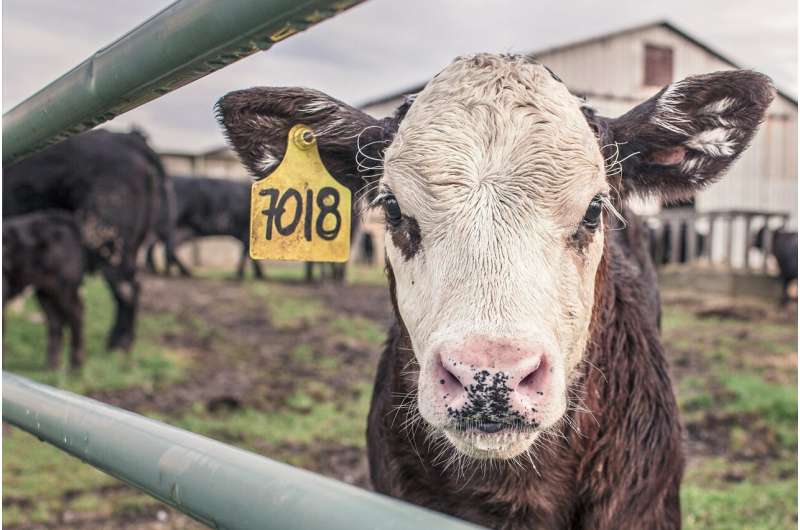This article has been reviewed according to Science X's editorial process and policies. Editors have highlighted the following attributes while ensuring the content's credibility:
fact-checked
peer-reviewed publication
trusted source
proofread
New research finds that reducing antibiotic usage in animal feed is not enough to combat antibiotic resistance

A new study led by the University of Oxford has found that natural evolution of antibiotic resistance genes has maintained resistance in bacteria despite a reduction in the use of antibiotics. The findings demonstrate the importance of understanding the regulatory evolution of resistance genes to strategically combat AMR.
The study, "Regulatory fine-tuning of mcr-1 increases bacterial fitness and stabilizes antibiotic resistance in agricultural settings," has been published in the Journal of the International Society for Microbial Ecology.
Antimicrobial resistance (AMR) is a serious and growing threat to global health, with 1.2 million people dying each year due to drug-resistant infections. The overuse and misuse of antibiotics is a major driver of AMR, and there is an urgent need to protect the efficacy of 'last-line' antibiotics to treat multidrug-resistant infections.
"Our study shows how evolution can rapidly stabilize resistance genes in pathogen populations, reducing the impact of restricting antibiotic consumption. Limiting consumption is one of most widely advocated strategies to combat AMR, and the main lesson of our work moving forward is that we need new, innovative strategies to actively eliminate AMR bacteria," says Professor Craig MacLean, Department of Biology, University of Oxford
In 2017, the Chinese government banned the use of last-line antibiotic colistin as a growth promotor in animal feed in response to the rapid spread of antibiotic-resistant bacteria Escherichia coli (E.coli) carrying mobile colistin resistance (MCR) genes. Bacteria carrying MCR genes are resistant to treatment with colistin and cause hard to treat drug-resistant infections in humans and animals.
The ban led to a 90% reduction in colistin consumption, and scientists expected to see a corresponding drop in rates of AMR. This is because the MCR gene is associated with fitness costs, such as reduced competitive ability and virulence. However, large-scale surveillance studies across China following the ban found that the decline in the mcr-1 gene was slower than anticipated.
Researchers at the University of Oxford led by Maclean explored this discrepancy by focusing on the regulatory region of DNA that controls the expression of the mcr-1 gene. They found that this region shows high levels of variation, and that certain variants were able to offset the fitness costs of the mcr-1 gene. By 'fine tuning' mcr-1 expression to a lower level, these variants enabled the bacteria to achieve high growth rates while simultaneously increasing colistin resistance.
The researchers then analyzed DNA sequence data from E.coli carrying mcr-1 from before and after the colistin ban. This revealed that the regulatory mutations that increased fitness in the lab had remained stable in E.coli populations from farms, and had hardly declined in response to the ban.
Lead researcher MacLean said, "Our results provide strong evidence that the evolution of the mcr-1 gene has helped to stabilize colistin resistance in agricultural settings, even though colistin use in agriculture has declined by 90%. This finding is of major importance for all future interventions targeting the reduction of antibiotic usage, demonstrating the need to consider the evolution and transmission of resistance genes to introduce viable strategies to reduce resistance."
Professor Tim Walsh, director of biology at the Ineos Oxford Institute and co-author on the paper, said, "Colistin resistance across many strains of E.coli and in diverse environments from pig farms to hospital wards should act as our warning of the dangers of antibiotic overuse and misuse. Simply put, it is not enough to reduce antibiotic consumption in order to effectively combat antibiotic resistance. We need urgent and innovative approaches to combat antibiotic resistance, and new strategies to protect our last-resort antibiotics for when we need them most."
More information: Lois Ogunlana et al, Regulatory fine-tuning of mcr-1 increases bacterial fitness and stabilises antibiotic resistance in agricultural settings, The ISME Journal (2023). DOI: 10.1038/s41396-023-01509-7
Journal information: ISME Journal
Provided by University of Oxford





















